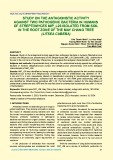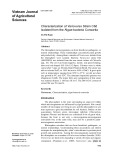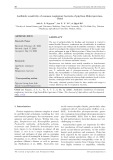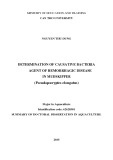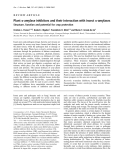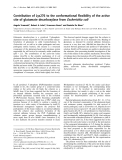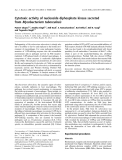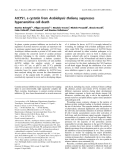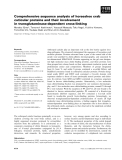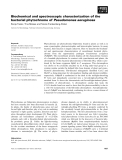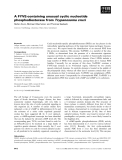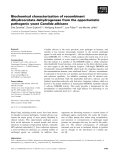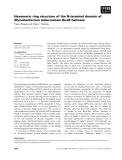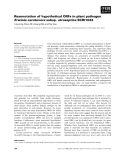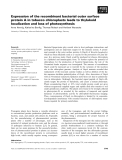
Pathogenic bacteria
-
Study on the antagonistic activity against two pathogenic bacteria in humans (Staphylococcus aureus and Streptococcus pneumoniae) of the Streptomyces MIP_L26 (Called MIP_L26), isolated from the soil in the root zone of the May Chang tree; to investigate the biological characteristics of MIP_L26.
 6p
6p  vipanly
vipanly
 28-10-2024
28-10-2024
 0
0
 0
0
 Download
Download
-
The rhizosphere microorganisms can form beneficial, pathogenic, or neutral relationships. These relationships can promote plant growth and productivity. Among them, a number of Variovorax isolates from the rhizosphere were isolated. Bacteria Variovorax strain C6d (AB552893) was isolated from the non axenic culture of Chlorella spp., C6.
 8p
8p  vibecca
vibecca
 01-10-2024
01-10-2024
 4
4
 2
2
 Download
Download
-
They can survive in a highly competitive microbial environment. Bacteriocins attack their targeted bacterial cells through different mechanisms. Understanding different mechanisms that induced cell death will enable researchers to develop methodologies to limit this life-threatening problem.
 10p
10p  mudbound
mudbound
 10-12-2021
10-12-2021
 14
14
 2
2
 Download
Download
-
The results revealed that the Invitro release within 24 hours of chitosan nanoparticles conjugate bacteriocin was controlled by about (79%) with cumulative and sustained effect when compared with free bacteriocin (94%).
 7p
7p  mudbound
mudbound
 10-12-2021
10-12-2021
 8
8
 2
2
 Download
Download
-
This study aimed to investigate the antimicrobial resistance of five major respiratory pathogens in pigs of Hubei province, China, from October to December, 2019. Antibiotic susceptibility testing for Streptococcus suis, Haemophilus parasuis, Pasteurella multocida, Bordetella bronchiseptica and Actinobacillus pleuropneumoniae was determined to representatives of relevant antibiotic classes.
 6p
6p  larachdumlanat129
larachdumlanat129
 19-01-2021
19-01-2021
 10
10
 1
1
 Download
Download
-
The objectives: At least one Bacillus subtilis strain was isolated in some provinces in the Mekong Delta, having probiotic properties such as: ability to produce digestive enzymes (amylase, protease, lipase); resistance to digestive juice (gastric juice and bile acid), ability to adhere to intestinal mucus and resistance to some pathogenic bacteria (S. enterica, E. coli).
 28p
28p  cotithanh321
cotithanh321
 06-08-2019
06-08-2019
 36
36
 3
3
 Download
Download
-
General objective of the study: Survey and assessment of hemorrhage appear on a mudskipper farm in Bac Lieu province. Identifying characteristics of Pathology in fish pathogens which proposed solutions to prevent and treat the disease effectively.
 27p
27p  change05
change05
 08-06-2016
08-06-2016
 38
38
 5
5
 Download
Download
-
Insect pests and pathogens (fungi, bacteria and viruses) are responsible for severe crop losses. Insects feed directly on the plant tissues, while the pathogens lead to damage or death of the plant. Plants have evolved a certain degree of resistance through the production of defence compounds, which may be aproteic, e.g. antibiotics, alkaloids, terpenes, cyanogenic glucosides or proteic, e.g. chitinases,b-1,3-glu-canases, lectins, arcelins, vicilins, systemins and enzyme inhibitors.
 16p
16p  research12
research12
 23-04-2013
23-04-2013
 44
44
 3
3
 Download
Download
-
Glutamate decarboxylase is a pyridoxal 5¢-phosphate-dependent enzyme responsible for the irreversiblea-decar-boxylation of glutamate to yield 4-aminobutyrate. In Escherichia coli, as well as in other pathogenic and non-pathogenic enteric bacteria, this enzyme is a structural component of the glutamate-based acid resistance system responsible for cell survival in extremely acidic conditions (pH
 8p
8p  tumor12
tumor12
 22-04-2013
22-04-2013
 30
30
 3
3
 Download
Download
-
Pathogenicity ofMycobacterium tuberculosisis closely rela-ted to its ability to survive and replicate in the hostile envi-ronment of macrophages. For some pathogenic bacteria, secretion of ATP-utilizing enzymes into the extracellular environment aids in pathogen survival via P2Z receptor-mediated, ATP-induced death of infected macrophages. A component of these enzymes is nucleoside diphosphate kinase (Ndk). Thendkgenewas cloned fromM. tuberculosis H37Rv and expressed inEscherichia coli.
 10p
10p  tumor12
tumor12
 20-04-2013
20-04-2013
 42
42
 3
3
 Download
Download
-
Báo cáo khoa học: AtCYS1, a cystatin from Arabidopsis thaliana, suppresses hypersensitive cell death
In plants, cysteine protease inhibitors are involved in the regulation of protein turnover and play an important role in resistance against insects and pathogens. AtCYS1from Arabidopsis thalianaencodes a protein of 102 amino acids that contains the conserved motif of cysteine protease inhibitors belonging to the cystatin superfamily (Gln-Val-Val-Ala-Gly). Recombinant A. thaliana cystatin-1 (AtCYS1) was expressed in Escherichia coliand purified.
 12p
12p  fptmusic
fptmusic
 16-04-2013
16-04-2013
 25
25
 3
3
 Download
Download
-
Arthropod cuticles play an important role as the first barrier against inva-ding pathogens. We extensively determined the sequences of horseshoe crab cuticular proteins. Proteins extracted from a part of the ventral side of the cuticle were purified by chitin-affinity chromatography, and separated by two-dimensional SDS⁄PAGE. Proteins appearing on the gel were designa-ted high molecular mass chitin-binding proteins, and these proteins were then grouped into classes based on their approximate isoelectric points and predominant amino acid compositions. ...
 13p
13p  fptmusic
fptmusic
 12-04-2013
12-04-2013
 34
34
 2
2
 Download
Download
-
Phytochromes are photochromic biliproteins found in plants as well as in some cyanotrophic, photoautotrophic and heterotrophic bacteria. In many bacteria, their function is largely unknown. Here we describe the biochemi-cal and spectroscopic characterization of recombinant bacterial phyto-chrome from the opportunistic pathogen Pseudomonas aeruginosa (PaBphP). The recombinant protein displays all the characteristic features of a bonafide phytochrome.
 0p
0p  awards
awards
 06-04-2013
06-04-2013
 44
44
 2
2
 Download
Download
-
Cyclic-nucleotide-specific phosphodiesterases (PDEs) are key players in the intracellular signaling pathways of the important human pathogen Trypano-soma cruzi. We report herein the identification of an unusual PDE from this protozoal organism. This enzyme, TcrPDEC, is a member of the class I PDEs, as determined from the presence of a characteristic signature sequence and from the conservation of a number of functionally important amino acid residues within its catalytic domain.
 11p
11p  dell39
dell39
 27-03-2013
27-03-2013
 40
40
 2
2
 Download
Download
-
Candida albicansis the most prevalent yeast pathogen in humans, and recently it has become increasingly resistant to the current antifungal agents. In this study we investigatedC. albicansdihydroorotate dehydroge-nase (DHODH, EC 1.3.99.11), which catalyzes the fourth step ofde novo pyrimidine synthesis, as a new target for controlling infection.
 9p
9p  inspiron33
inspiron33
 25-03-2013
25-03-2013
 48
48
 4
4
 Download
Download
-
Type III secretion systems of Gram-negative pathogenic bacteria allow the injection of effector proteins into the cytosol of host eukaryotic cells. Cros-sing of the eukaryotic plasma membrane is facilitated by a translocon, an oligomeric structure made up of two bacterial proteins inserted into the host membrane during infection.
 10p
10p  galaxyss3
galaxyss3
 19-03-2013
19-03-2013
 36
36
 4
4
 Download
Download
-
Hexameric DnaB helicase unwinds the DNA double helix during replica-tion of genetic material in bacteria. DnaB is an essential bacterial protein; therefore, it is an important potential target for antibacterial drug disco-very. We report a crystal structure of the N-terminal region of DnaB from the pathogen Mycobacterium tuberculosis(MtDnaBn), determined at 2.0 A˚ resolution.
 8p
8p  galaxyss3
galaxyss3
 07-03-2013
07-03-2013
 50
50
 4
4
 Download
Download
-
Over-annotation of hypothetical ORFs is a common phenomenon in bacte-rial genomes, which necessitates confirming the coding reliability of hypo-thetical ORFs and then predicting their functions. The important plant pathogenErwinia carotovorasubsp. atrosepticaSCRI1043 (Eca1043) is a typical case because more than a quarter of its annotated ORFs are hypo-thetical.
 9p
9p  media19
media19
 05-03-2013
05-03-2013
 40
40
 3
3
 Download
Download
-
Bacterial lipoproteins play crucial roles in host–pathogen interactions and pathogenesis and are important targets for the immune system. A promi-nent example is the outer surface protein A (OspA) ofBorrelia burgdorferi, which has been efficiently used as a vaccine for the prevention of Lyme dis-ease.
 10p
10p  media19
media19
 04-03-2013
04-03-2013
 37
37
 3
3
 Download
Download
-
Blackleg (Leptosphaeria maculansand Leptosphaeria biglobosa) and black spot (Alternaria brassicicola) fungi are devastating plant pathogens known to detoxify the plant defence metabolite, brassinin. The significant roles of brassinin as a crucifer phytoalexin and as a biosynthetic precursor of sev-eral other plant defences make it important in plant fitness.
 17p
17p  vinaphone15
vinaphone15
 28-02-2013
28-02-2013
 44
44
 2
2
 Download
Download
CHỦ ĐỀ BẠN MUỐN TÌM








